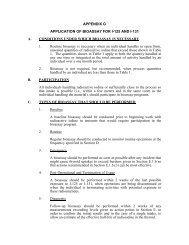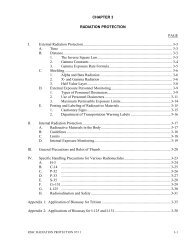CHAPTER 2 FUNDAMENTAL RADIATION CONCEPTS PAGE I ...
CHAPTER 2 FUNDAMENTAL RADIATION CONCEPTS PAGE I ...
CHAPTER 2 FUNDAMENTAL RADIATION CONCEPTS PAGE I ...
- No tags were found...
You also want an ePaper? Increase the reach of your titles
YUMPU automatically turns print PDFs into web optimized ePapers that Google loves.
1. Alpha ParticlesAn alpha particle is a helium nucleus stripped of its orbital electrons. It isemitted from a radioactive atom with a velocity of about 1/20 that of thespeed of light and with energies ranging from 4 to 9 MeV. Alphas causeionizations in matter when they are deflected by the positive charge of anucleus and pull the orbital electrons (attracted by the alpha's positivecharge) along with them. Alpha particles also cause excitation along theirpath by pulling inner orbital electrons to outer orbits. Energy is then givenoff by the atom as fluorescent radiation (low energy x-rays) when theelectrons drop back down to the inner orbital vacancies.Because of its relatively large mass (2 neutrons and 2 protons), highelectrical charge (2+) and low velocity, the specific ionization of an alphaparticle is very high. That is, it creates many ion pairs in a very short pathlength. Because of this, it loses all of its energy in a very short distance.The range in air is only several centimeters even for the most energeticalpha particles.Since the alpha particle has a very limited range in matter, it presents noexternal radiation hazard to man. Many alpha particles cannot penetratethe protective layer of skin. However, once inside the body, surrounded byliving tissue, damage will be to the local area in which the alpha emitter isdeposited. Thus, alpha emitters are an internal hazard and intake to thebody must be prevented.2. Beta ParticlesBeta particles are emitted from the nucleus of a radioactive atom with awide range of energies up to some maximum value. When a beta isemitted that is below the maximum value, the neutrino carries away therest of the energy.Beta particles, like alpha particles, lose their energy by ionization andexcitation, but because of their small mass (1/7300 of an alpha) and lowercharge (1/2 of that of an alpha) the interactions take place at less frequentintervals. Therefore, the beta particles do not produce as many ion pairsper centimeter of path as alpha particles, and thus, have a greater range inmatter. The beta particle's range in matter depends on its energy and thecomposition of the material.a) Bremsstrahlung X-ray Production:Beta particles can interact with the nucleus of an atom and give riseto x-rays by a method called Bremsstrahlung. Bremsstrahlung(German for "Braking Radiation") occurs when a high-speed beta2-12 RSSC <strong>FUNDAMENTAL</strong> <strong>RADIATION</strong> <strong>CONCEPTS</strong> 072011












